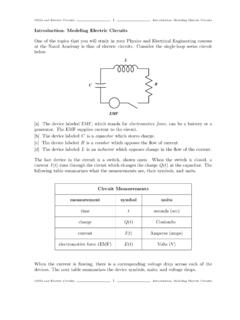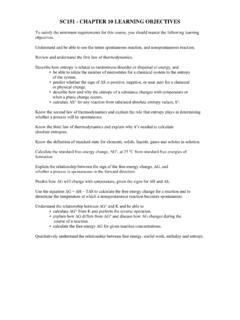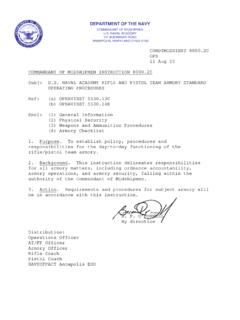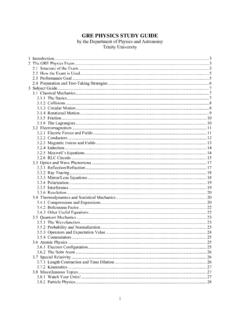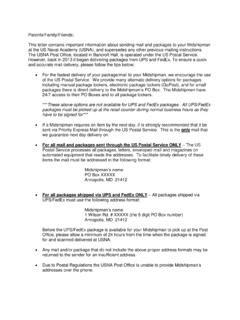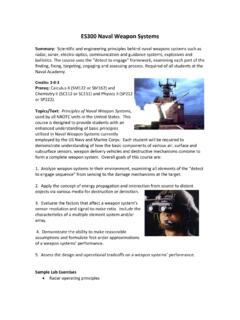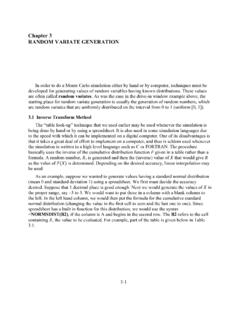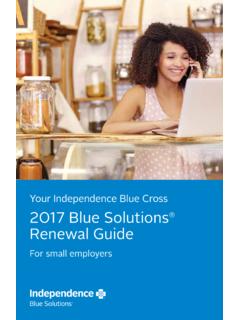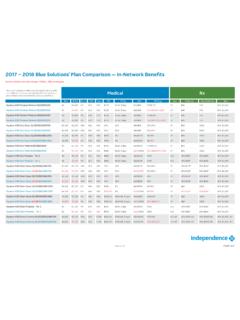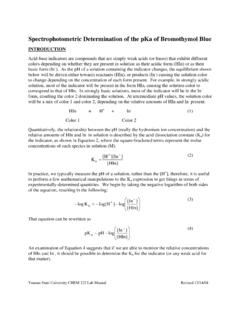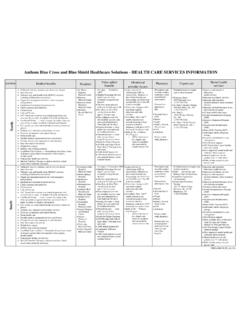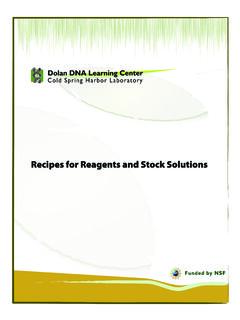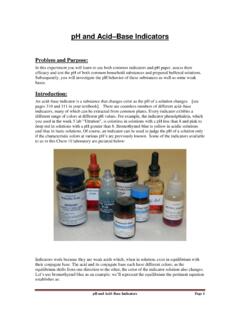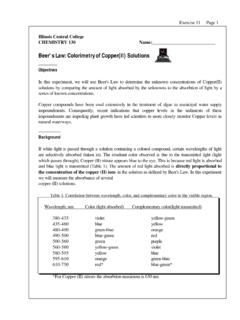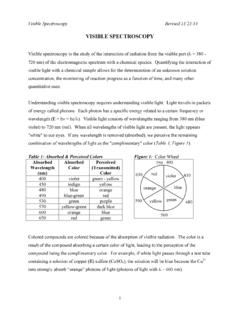Transcription of SPECTROSCOPIC ANALYSIS OF DYES – MORE THAN PRETTY …
1 E37B1-1 Experiment 37B-1 FV 3-6-15 SPECTROSCOPIC ANALYSIS OF dyes more THAN PRETTY COLORS1 PART 1 MATERIALS: FD&C food stock solutions (Red, blue , Yellow), 4 50 mL beakers, 250 mL beaker, 3 10 mL volumetric pipets, 2 5 mL volumetric pipets, 4 100 mL volumetric flasks, plastic dropper, Spectronic 200, cuvettes. PURPOSE: The purpose of this experiment is to understand how light interacts with a dye solution and to use this knowledge to determine the amount of dye in an unknown.
2 LEARNING OBJECTIVES: By the end of this experiment, the student should be able to demonstrate the following proficiencies: 1 This lab is based on SPECTROSCOPIC ANALYSIS of Food dyes by Barbara A. Reisner, Joycette Santos-Santori, Dawn Rickey, and Melonie Teichert. 1. Prepare diluted solutions and calculate their concentrations. 2. Understand what an absorbance spectrum is and select max. 3. Relate the color observed of a solution to its max value (and color absorbed).
3 4. Understand Beer s Law and what factors affect it. 5. Create a calibration curve using standard solutions . 6. Determine a concentration of an unknown using a calibration curve. PRE-LAB: Complete the pre-lab questions on pages E37B1-7 and E37B1-8 before lab. DISCUSSION: When light of a particular wavelength ( ) is absorbed by a sample, the intensity of light that initially strikes the sample (Io) can be compared to the intensity of light that passes through the sample (I). The transmittance (T) is defined as the fraction of the light striking the sample that passes through the sample: T = I/Io %T = (I/Io) x 100 Absorbance (A) is related to transmittance logarithmically: A = log10(1/T) = log10(Io/I) = log(%T/100) Thus, when no light is absorbed by a sample, I = Io, T = 1, %T = 100, and A = 0.
4 Conversely, when all of the light that strikes a sample is absorbed by it, I = 0, T = 0, %T = 0, and A is infinite. Mars I Io E37B1-2In this lab, you will be using an instrument called a spectrophotometer, which measures %T and A at various wavelengths to investigate food colorings in the visible region of the electromagnetic spectrum. What are the FD&C dyes ? FD&C (Food, Drug, & Cosmetics) dyes are additives approved by the Food & Drug Administration (FDA) to enhance the color of consumer products.
5 While there are many natural dyes derived from natural products ( , beet juice, tumeric, saffron, paprika), the manmade FD&C dyes are considered safe for human consumption. A list of dyes that are currently approved by the FDA is provided below. The molecular structures for some of these dyes can be found below: FD&C blue No. 1 - Brilliant blue FCF, E133 ( blue shade) FD&C blue No. 2 - Indigotine, E132 (dark blue shade) FD&C Green No. 3 - Fast Green FCF, E143 (bluish green shade) FD&C Red No.
6 40 - Allura Red AC, E129 (red shade) FD&C Red No. 3 - Erythrosine, E127 (pink shade) FD&C Yellow No. 5 - Tartrazine, E102 (yellow shade) FD&C Yellow No. 6 - Sunset Yellow FCF, E110 (orange shade) The color choices provided by the FD&C dyes are somewhat limited. However, it is possible to produce a great number of colors by mixing these dyes . If you read the ingredient lists on consumer products, you may see the presence of FD&C dyes or other natural ingredients used to produce the colors that we associate with these products.
7 blue No. 2 CCCCCNHCCHNHCCHCCHCHCCHHC-O3 SOOSO3- YELLOW No. 6 RED No. 3 NNCCHCHCCCHCHCCCHHCCHCC HCCH-O3 SHOSO3- CCCCCOCCCCHCHCCCCI-OIIOIHCHCCHCHCCOO- Electromagnetic Spectrum (this is better viewed in color) E37B1-3 PROCEDURE: You will work with a lab partner. Each lab partner must record the data and answer the questions individually, after discussing them.
8 Part A. Solution Preparation 1. Into separate dry, 50 mL beakers obtain the following: ~20 mL stock blue , ~20 mL stock Yellow, and ~20 mL stock Red solutions . 2. Dividing the work among the lab partners, prepare a 1:10 diluted solution of each of the stock dye solutions ( blue , Yellow, Red) by using these steps: a. Pipet 10 mL of the stock solution into a 100 mL volumetric flask. (If the pipet is wet, pre-rinse it with a little of the stock solution and discard the rinse.) b. Using distilled water, dilute the solution to the line of the volumetric flask.
9 Use a dropper to add the last drops of water. c. Cap the flask securely and invert the flask a couple of times to mix the contents. d. You should have 3 diluted (1:10) solutions of blue , Yellow, and Red. 3. Once the diluted blue and Yellow solutions are prepared (from step 2), mix equal volumes together in a small beaker. For example, pipet 5 mL of the diluted blue solution into the beaker, then with a clean pipet, pipet 5 mL of the diluted Yellow solution into the beaker. (Make sure not to contaminate your solutions by using dirty pipets.)
10 Mix the solution with a glass stirring rod. Was the color what you expected? 4. Once the diluted Red solution is prepared (from step 2), prepare a further diluted solution of it by pipetting 20 mL of the diluted Red solution into a 100 mL volumetric flask. You will need to use the 10 mL pipet twice. Fill to the line with distilled water and mix. How does this further diluted Red solution compare to the original one? 5. Record your observations of each solution. 6. Once all of your solutions are prepared, inform your instructor that you are ready to obtain the absorbance spectrum of each solution.
